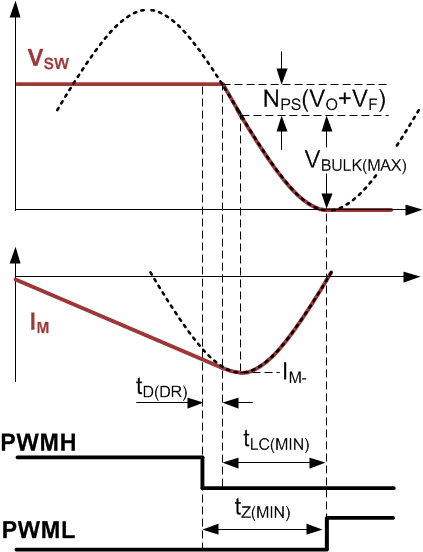ZHCSOY9 december 2021 UCC28781
PRODUCTION DATA
- 1
- 1 特性
- 2 应用
- 3 说明
- 4 Revision History
- 5 Pin Configuration and Functions
- 6 Specifications
-
7 Detailed Description
- 7.1 Overview
- 7.2 Functional Block Diagram
- 7.3
Detailed Pin Description
- 7.3.1 BUR Pin (Programmable Burst Mode)
- 7.3.2 FB Pin (Feedback Pin)
- 7.3.3 REF Pin (Internal 5-V Bias)
- 7.3.4 VDD Pin (Device Bias Supply)
- 7.3.5 P13 and SWS Pins
- 7.3.6 S13 Pin
- 7.3.7 IPC Pin (Intelligent Power Control Pin)
- 7.3.8 RUN Pin (Driver and Bias Source for Isolator)
- 7.3.9 PWMH and AGND Pins
- 7.3.10 PWML and PGND Pins
- 7.3.11 SET Pin
- 7.3.12 RTZ Pin (Sets Delay for Transition Time to Zero)
- 7.3.13 RDM Pin (Sets Synthesized Demagnetization Time for ZVS Tuning)
- 7.3.14 XCD Pin
- 7.3.15 CS, VS, and FLT Pins
- 7.4
Device Functional Modes
- 7.4.1 Adaptive ZVS Control with Auto-Tuning
- 7.4.2 Dead-Time Optimization
- 7.4.3 EMI Dither and Dither Fading Function
- 7.4.4 Control Law Across Entire Load Range
- 7.4.5 Adaptive Amplitude Modulation (AAM)
- 7.4.6 Adaptive Burst Mode (ABM)
- 7.4.7 Low Power Mode (LPM)
- 7.4.8 First Standby Power Mode (SBP1)
- 7.4.9 Second Standby Power Mode (SBP2)
- 7.4.10 Startup Sequence
- 7.4.11 Survival Mode of VDD (INT_STOP)
- 7.4.12
System Fault Protections
- 7.4.12.1 Brown-In and Brown-Out
- 7.4.12.2 Output Over-Voltage Protection (OVP)
- 7.4.12.3 输入过压保护 (IOVP)
- 7.4.12.4 FLT 引脚上的过热保护 (OTP)
- 7.4.12.5 CS 引脚上的过热保护 (OTP)
- 7.4.12.6 可编程过功率保护 (OPP)
- 7.4.12.7 峰值功率限制 (PPL)
- 7.4.12.8 输出短路保护 (SCP)
- 7.4.12.9 过流保护 (OCP)
- 7.4.12.10 External Shutdown
- 7.4.12.11 Internal Thermal Shutdown
- 7.4.13 Pin Open/Short Protections
-
8 Application and Implementation
- 8.1 Application Information
- 8.2
Typical Application Circuit
- 8.2.1 Design Requirements for a 60-W, 15-V ZVSF Bias Supply Application with a DC Input
- 8.2.2 Detailed Design Procedure
- 8.2.3 Application Curves
- 9 Power Supply Recommendations
- 10Layout
- 11Device and Documentation Support
- 12Mechanical, Packaging, and Orderable Information
7.3.12 RTZ Pin (Sets Delay for Transition Time to Zero)
The dead-time between PWMH falling edge and PWML rising edge (tZ) serves as the wait time for VSW transition from its high level down to the target ZVS point. Since the optimal tZ varies with VBULK, the internal dead-time optimizer automatically extends tZ as VBULK is less than the highest voltage of the input bulk capacitor (VBULK(MAX)). The circulating energy for ZVS can be further reduced, obtaining higher efficiency at low line versus a fixed dead-time over a wide line voltage range. A resistor on the RTZ pin (RRTZ) programs the minimum tZ (tZ(MIN)) at VBULK(MAX), which is the sum of the propagation delay of the synchronous rectifier driver (tD(DR)) and the minimum resonant transition time of VSW falling edge (tLC(MIN)).
where
- KRTZ is equal to 11.2 × 1011 (unit: F-1) for VSET = 0 V
- KRTZ is equal to 5.6 × 1011(unit: F-1) for VSET = 5 V
 Figure 7-16 RTZ Setting for the Falling-edge Transition of VSW
Figure 7-16 RTZ Setting for the Falling-edge Transition of VSWAs illustrated in Figure 7-16, when PWMH turns off QSR after tD(DR) delay, the negative magnetizing current (iM-) becomes an initial condition of the resonant tank formed by magnetizing inductance (LM) and the switch-node capacitance (CSW). CSW is the total capacitive loading on the switch-node, including the junction capacitance (COSS) of the primary switch, reflected secondary-side capacitance, intra-winding capacitance of the transformer, the snubber capacitor, and parasitic capacitance of the PCB traces between switch-node and ground. Unlike a conventional valley-switching flyback converter, the resonance of the Zconverter at high line does not begin at the peak of the sinusoidal trajectory. The transition time of VSW takes less than half of the resonant period. The following tLC(MIN) expression quantifies the transition time for RRTZ calculation, where an arccosine term represents the initial angle at the beginning of resonance. As an example, the value of π minus the arccosine term at VBULK(MAX) of 375 V, VO of 20 V, and NPS of 5 is around 0.585π, which is close to one quarter of the resonant period.
